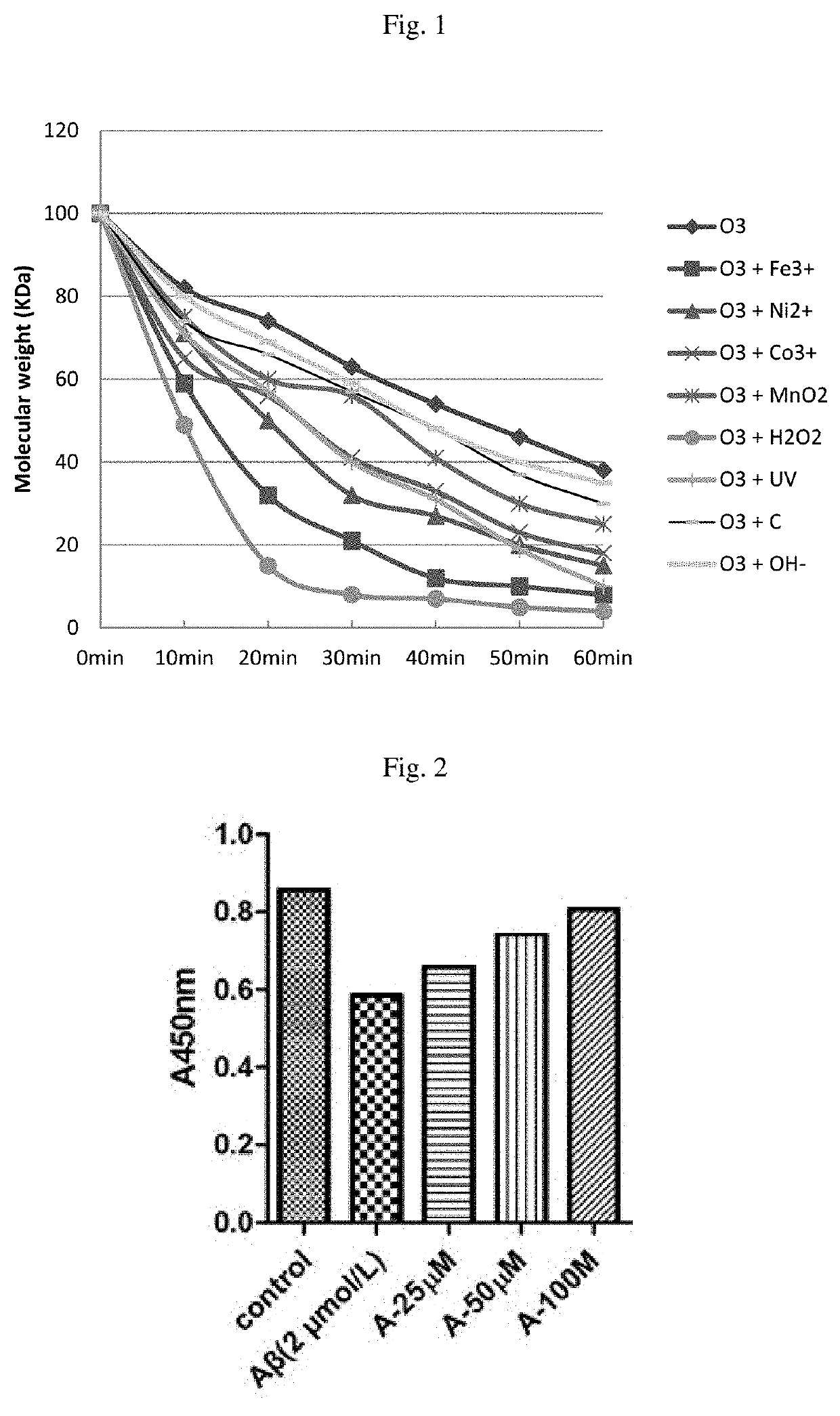Method of degrading polysaccharide using ozone
a polysaccharide and ozone technology, applied in the field of degrading polysaccharides, can solve the problems of inability to use ozone acid hydrolysis cannot be used in the production process, and the use of ozone in controllable degradation of polysaccharides has not been reported, so as to reduce the amount of acid or base used, high water solubility, and high efficiency
- Summary
- Abstract
- Description
- Claims
- Application Information
AI Technical Summary
Benefits of technology
Problems solved by technology
Method used
Image
Examples
example 1
[0051]Step (1): Extraction of Hericium erinaceus polysaccharide. After the medicinal material was dried and pulverized, 5 kg was weighed into a 100 L reactor with a condensed water recovery device, immersed in 50 L of water for 12 hr, stirred, and heated. When the temperature was increased to 100° C., timing was started. At 8 hr of the extraction, the heating was stopped. The extract was discharged when cooled down to below 50° C. with cooling water, and filtered through a filter cloth. The filtrate was precipitated by adding 100 L of ethanol (95%), and allowed to stand for 12 hr. The supernatant was removed, and the precipitate was collected by centrifugation, vacuum dried under reduced pressure, pulverized and weighed to obtain 560 g of a polysaccharide product.
Step (2): Degradation of Hericium erinaceus polysaccharide. 400 g of the polysaccharide powder obtained above was weighed, mixed with 4 L of water, and heated to promote dissolution. It was placed for about 4 hr. When the t...
example 2
[0052]Step (1): 5.0 Kg of Poria cocos powder was weighed, and extracted by the same method as in Example 1 to give 610 g of polysaccharide powder.
[0053]The pressure in step (2) was set to 0.9 MPa, and other parameters were the same as in Example 1.
[0054]Steps (3) and (4) were the same as in Example 1. 365.2 g of degraded Poria cocos polysaccharide was obtained after degradation. The molecular weights before and after degradation were determined to be 740 KDa and 77 KDa, respectively. The results are shown in Table 1.
example 3
[0055]Step (1): 5.0 Kg of Tremella powder was weighed, and extracted by the same method as in Example 1 to give 720 g of polysaccharide powder.
Step (2): the pressure was set to 0.2 MPa, the degradation time was 3 hr, and other parameters were the same as in Example 1.
Step (3): It was different from that of Example 1 in that the sample treatment after the reaction was ethanol precipitation. Specifically, 2 volumes of 95% ethanol were added to the filtrate, stirred to make the precipitate uniform, and placed in a cold storage at 4° C. overnight. Thereafter, the supernatant was aspirated, the lower layer was centrifuged, and the precipitate was collected, dried in an oven, pulverized and weighed to be 293.2 g.
Step (4) was the same as in Example 1. The molecular weights before and after degradation were determined to be 530 KDa and 46 KDa, respectively. The results are shown in Table 1.
PUM
| Property | Measurement | Unit |
|---|---|---|
| Temperature | aaaaa | aaaaa |
| Fraction | aaaaa | aaaaa |
| Fraction | aaaaa | aaaaa |
Abstract
Description
Claims
Application Information
 Login to View More
Login to View More - R&D
- Intellectual Property
- Life Sciences
- Materials
- Tech Scout
- Unparalleled Data Quality
- Higher Quality Content
- 60% Fewer Hallucinations
Browse by: Latest US Patents, China's latest patents, Technical Efficacy Thesaurus, Application Domain, Technology Topic, Popular Technical Reports.
© 2025 PatSnap. All rights reserved.Legal|Privacy policy|Modern Slavery Act Transparency Statement|Sitemap|About US| Contact US: help@patsnap.com

